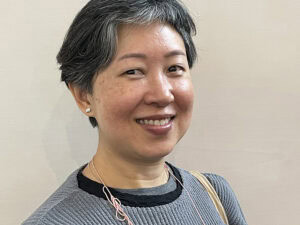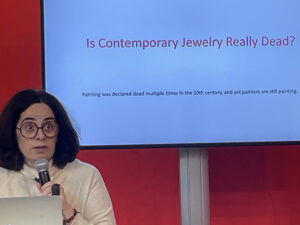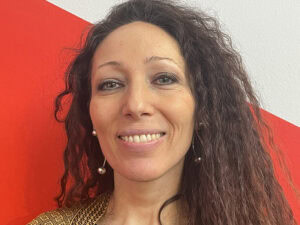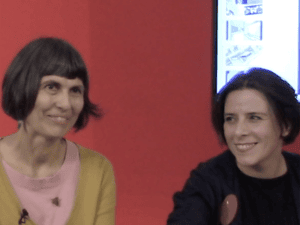Patti Bleicher and Eileen David started Gallery Loupe in Montclair, New Jersey, United States, six years ago. They show a roster of both established and emerging international artists and are interested in furthering the dialogue that contemporary jewelry evokes. In February they asked Kiff Slemmons, an established American artist, to show her most recent work in an exhibition called Huesos. I caught up with Kiff and asked her a few questions about her work and her interests.

Kiff Slemmons: These pieces emerged from an art residence at Arte Papel Oaxaca. The artist and members of the atelier did the work together. Early pieces referenced African jewelry with discs built up into sculptural bead forms. Later pieces exhibit the techniques of folding, cutting and hollow-punching, rolled and formed paper pulp. The atelier is dedicated to ‘reviving the pre-Columbian tradition of making paper from natural fibers.’ The result of this project is a collection of paper jewelry, which is highly sculptural and utilizes indigenous plants, fibers, natural and synthetic dyes.
Talking about paper in Oaxaca involves countering assumptions about the material, its fragility versus strength, the metaphoric implications of paper in this regard, in relation to books and the culture at large. What paper meant in pre-contact culture in Mexico, its magnified significance after conquest and its current place in culture today. How I came to work as I did there means looking at my previous work, how it might have led to such a project which involves a kind of world view through jewelry and writing. My work is really not technique determined, even with the paper. It’s ideas that interest me first and the possibility of being poetic in a visual language.
Patti Bleicher and Eileen David started Gallery Loupe in Montclair, New Jersey, United States, six years ago. They show a roster of both established and emerging international artists and are interested in furthering the dialogue that contemporary jewelry evokes. In February they asked Kiff Slemmons, an established American artist, to show her most recent work in an exhibition called Huesos. I caught up with Kiff and asked her a few questions about her work and her interests.

Kiff Slemmons: These pieces emerged from an art residence at Arte Papel Oaxaca. The artist and members of the atelier did the work together. Early pieces referenced African jewelry with discs built up into sculptural bead forms. Later pieces exhibit the techniques of folding, cutting and hollow-punching, rolled and formed paper pulp. The atelier is dedicated to ‘reviving the pre-Columbian tradition of making paper from natural fibers.’ The result of this project is a collection of paper jewelry, which is highly sculptural and utilizes indigenous plants, fibers, natural and synthetic dyes.
Talking about paper in Oaxaca involves countering assumptions about the material, its fragility versus strength, the metaphoric implications of paper in this regard, in relation to books and the culture at large. What paper meant in pre-contact culture in Mexico, its magnified significance after conquest and its current place in culture today. How I came to work as I did there means looking at my previous work, how it might have led to such a project which involves a kind of world view through jewelry and writing. My work is really not technique determined, even with the paper. It’s ideas that interest me first and the possibility of being poetic in a visual language.
Patti Bleicher and Eileen David started Gallery Loupe in Montclair, New Jersey, United States, six years ago. They show a roster of both established and emerging international artists and are interested in furthering the dialogue that contemporary jewelry evokes. In February they asked Kiff Slemmons, an established American artist, to show her most recent work in an exhibition called Huesos. I caught up with Kiff and asked her a few questions about her work and her interests.

Kiff Slemmons: These pieces emerged from an art residence at Arte Papel Oaxaca. The artist and members of the atelier did the work together. Early pieces referenced African jewelry with discs built up into sculptural bead forms. Later pieces exhibit the techniques of folding, cutting and hollow-punching, rolled and formed paper pulp. The atelier is dedicated to ‘reviving the pre-Columbian tradition of making paper from natural fibers.’ The result of this project is a collection of paper jewelry, which is highly sculptural and utilizes indigenous plants, fibers, natural and synthetic dyes.
Talking about paper in Oaxaca involves countering assumptions about the material, its fragility versus strength, the metaphoric implications of paper in this regard, in relation to books and the culture at large. What paper meant in pre-contact culture in Mexico, its magnified significance after conquest and its current place in culture today. How I came to work as I did there means looking at my previous work, how it might have led to such a project which involves a kind of world view through jewelry and writing. My work is really not technique determined, even with the paper. It’s ideas that interest me first and the possibility of being poetic in a visual language.
Huesos, the title of this show, means bones in Spanish. At that time I was considering work for an exhibition for the Chicago Cultural Center and I had the idea of making my designs in white only. The finished pieces became abstract in white and more pronounced as structure. The sense of paper was more present. There was a more direct line from plant to paper. As we made the initial elements, we came to see them as bones, the skeletons of the jewelry.

I was thinking of how we could reaffirm the use of paper in jewelry and of jewelry in art.
You were in New York recently for the opening of your show at Gallery Loupe and to give a talk at the 92nd St Y. I know you take these talks very seriously and they are as much about being creative for you as is making a piece of jewelry. Can you tell us a bit about this one?
Kiff Slemmons: Yes, I always put together talks as a kind of scripted performance. Making a talk is very much like making a piece of jewelry. And I want to wear it well if I’m out. I’ve often thought I wanted to write and ended up making jewelry as if it were writing, both in a narrative and a poetic sense. I want to communicate something about jewelry, its importance in the culture and at the same time include it seamlessly into the purview of art. There is an element of the subversive in the way I talk about jewelry, partly by being both poetic and plain speaking in my approach. I like to build up access to more complicated ideas through these layers. Form and structure are powerful tools.
For this particular talk I was asked to give an overview of my work, including the connection to paper. It was a challenge to articulate this course in my work since it was never that mysterious to me how, or more accurately why, I ended up working over many years with paper as well as metal.

I then talked about these threads in different bodies of work as well as the importance of exhibition as site for the work, almost more than the body as site for jewelry. For me it is not so necessary that jewelry be worn, though most of my work is quite wearable, but rather it is the implied site as jewelry that must remain. I like that they be shown as a collection of pieces. Their presence and what they are as art requires a collection of them. And though I cannot ‘afford’ to keep them together, the exhibition allows once again this particular presence.
Kiff Slemmons: In New York, walking on the street is about as rich as you can get – how many languages you hear in the space of a block, how many layers of culture in the people on the street, in the museums, looking in the windows, looking out. One of my favorite shows was XS (extra small) at the Metropolitan Museum, drawings and paintings on a very small scale and powerful and large in their presence. What jewelry can do. It would be hard to go to New York without at least one stop at the Met and the Egyptian rooms. And this time I spent a longer while with the lithic cases. A kind of meditation on ancient stone tools – beauty and use, ceremony and necessity – and what I might do with a cache of stone points in my work. Also in the Met, the Islamic galleries, where there was a particularly stunning calligraphy fragment that has remained in memory, along with a wonderful painting of a bat, holding out one wing. Thinking about the calligraphy – how powerful it was and yet I didn’t know at all what it said in the purely written language sense. But there is the visual language and that’s what I try to tap into . . . in use of materials and in the collection of parts.
I say in my talk that I’m trying to create a kind of geology of presence and certainly New York is that, with all its layers.

I know you were an English major in school and have a continuing interest in reading. So I am always interested in hearing about what are you reading?
Kiff Slemmons: In school I was aimed toward comparative literature – French and Russian. I ended up with a double major in French and Art. The art part was the last year of school when I took only art courses since I had enough credits already for a major in French.
Since I am a long time insomniac, I do most of my reading in the middle of the night. Sometimes it’s not good, because I get too involved and fail to go back to sleep. Oddly enough, The Girl with the Dragon Tattoo was a good one to ration each night. I liked it for more than wanting to know what was going to happen next. And also because it was so removed from my recent daytime thoughts. Right now I’m reading Art of the Andes, a kind of survey book, in anticipation of a trip to Peru. I know very little about this part of the world or its art. This book is well written and right off I liked the underpinnings of landscape in the discussion of both art and culture.
When did you move from Seattle to Chicago?
Kiff Slemmons: We moved in 2002.

Do you think your move affected your thoughts about what you wanted to do with jewelry?
Kiff Slemmons: I think all along I’ve tried to situate myself as a jeweler in the wider picture of art and culture. Not compartmentalized as a jeweler, a narrative jeweler, a Northwest jeweler, a metalsmith, a craftsman, though that’s where others put me nonetheless. Perhaps one person who most understood my particular bent was Ramona Solberg. We were close as friends and as lovers of travel, so called ethnic art and the Everyday. Otherwise, our work went in very different directions, but I was often identified as a student of Ramona’s. I suppose an important part of moving to Chicago was a different kind of freedom, a certain anonymity that was also liberating, allowing me to ‘come into my own.’ The move also coincided with the closing of gallery, which had already contributed enormously to following my threads through continuing exhibitions. The move to Chicago led to new ways of thinking about exhibitions in different contexts – new venues, both through working with Doug Dawson in an ethnographic gallery and in more public spaces like the Chicago Cultural Center for the exhibitions of Re:Pair and Imperfection and Pride of Paper several years later.
What is the thread of thought that runs through all your work? Can you talk about how it continues through from your earlier work in Seattle to this series of paper pieces?
Kiff Slemmons: Three threads that have run through my work over many years – scale, the language of material and the idea of more than one to make one – coalesced once again.

What are your ambitions?
Kiff Slemmons: We have discussed the sense of that word in the past. I don’t think I’ve had a strategy as many artists now speak about, sometimes using that word as a kind of military maneuver or conquest. For me it’s been more about how to live a rich life and somehow contribute to the culture. Rather than ambition I might determine a course according to how much energy there is, both to the idea and to the action. How much vitality. I’m not so interested in product, but I am interested in poetry. Which, of course, is mostly invisible.
I like to use the strength of the diminutive to counter assumptions about jewelry, to add to ideas about art and to contribute to the continuing worth of the physicality of ideas. Jewelry is not a usual site for art, though it often appears in museums as indicators and identifiers of past cultures. It is the unexpectedness of jewelry as art that has held my attention all these years.




